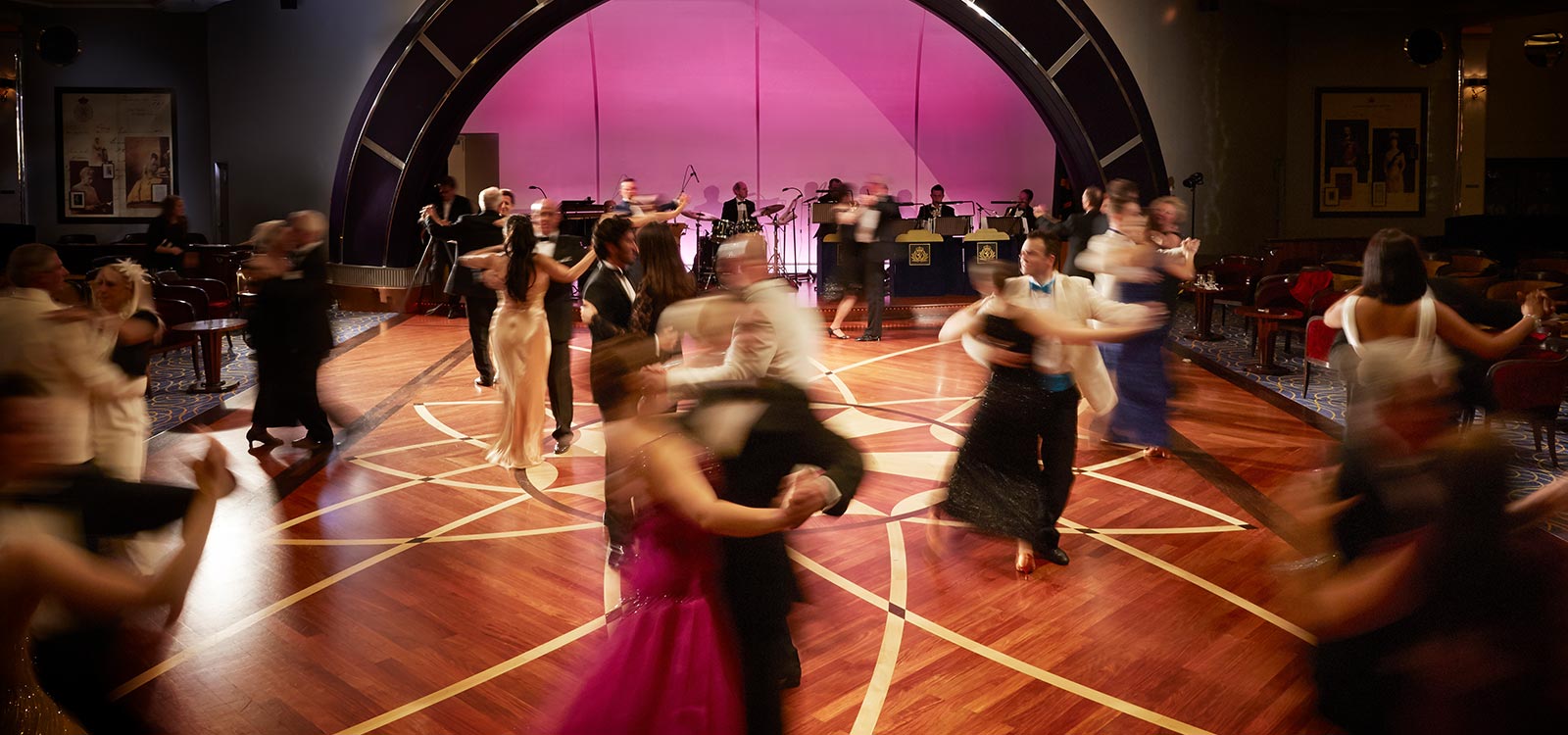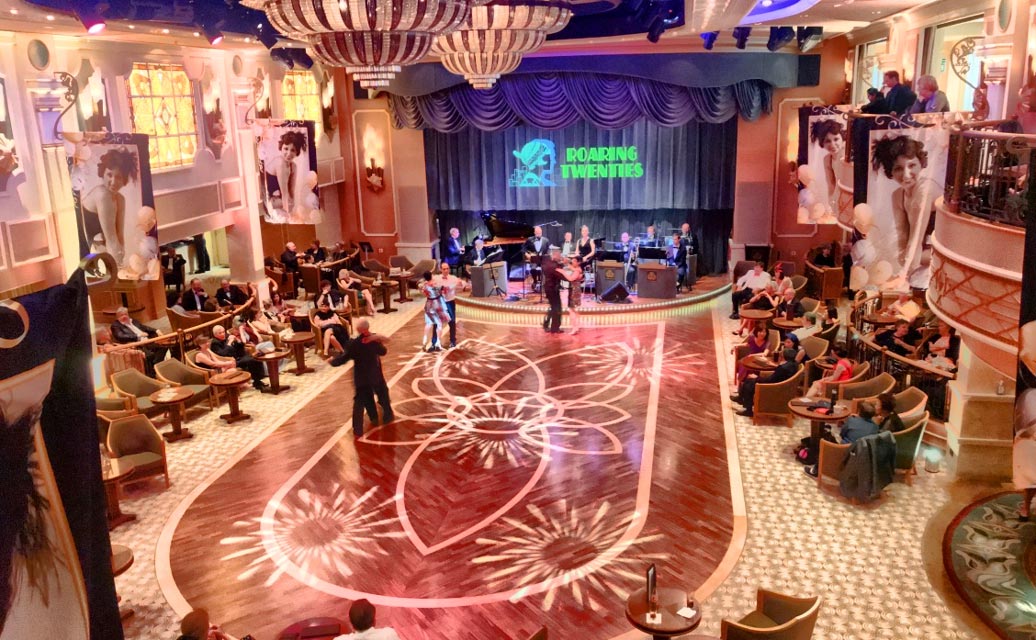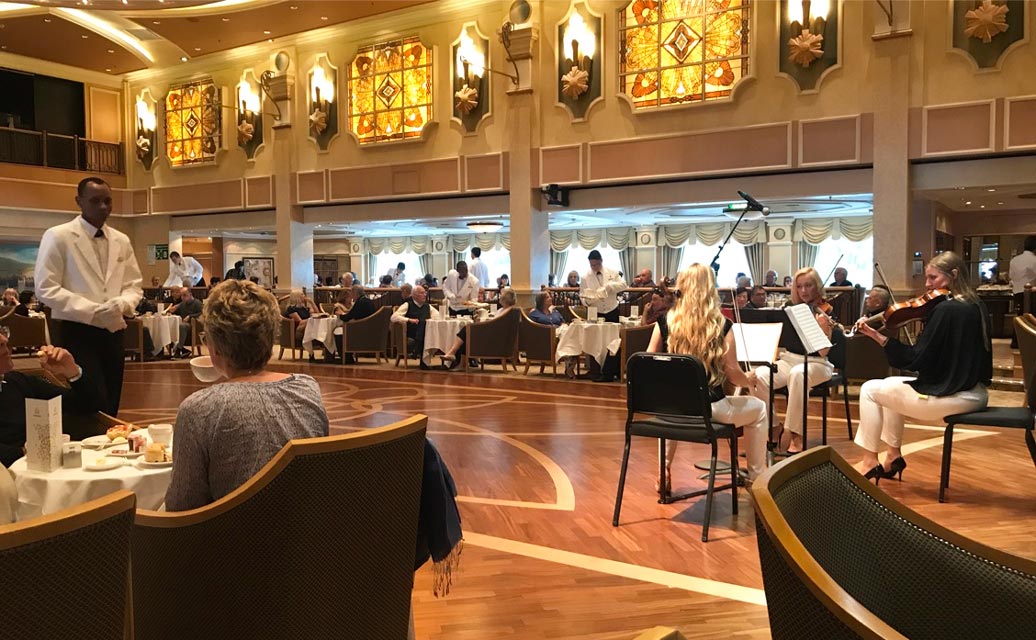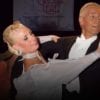Delta Dance enjoyed its first ever dance cruise on board the elegant Cunard Queen Elizabeth. Our 10-day journey from Vancouver to Alaska and back was a great experience for all the members of our group, and also enabled all of us to gain new skills.
There are lots of cruises to Alaska every summer. The main reason we chose this one was the Cunard tradition of dancing. All three Cunard ships boast a large dance floor (large in comparison to other lines). Other companies are reducing their dance options and in some cases removing dance floors entirely, replacing them with shops or other facilities.
The Cunard Queen Elizabeth floor measures about 22 feet x 50 feet in size. While this is smaller than that of an average ballroom dance studio, it’s still an impressive floor size for a cruise ship. The QE floor is amidships, which minimizes any effect of ship movement.
 Dancing is in the Cunard DNA. Almost any time you walk by the Queen’s Room, you can see people dancing. Private lessons. Group lessons. Tea dances. Sequence dancing. People dancing on an empty floor just because it was available.
Dancing is in the Cunard DNA. Almost any time you walk by the Queen’s Room, you can see people dancing. Private lessons. Group lessons. Tea dances. Sequence dancing. People dancing on an empty floor just because it was available.
Starting in the afternoon the Queen’s Room opens to general dancing. At 8:30pm the Queen’s Room Orchestra takes their place at one end and the real magic begins.
The orchestra has adapted many popular songs to strict-tempo styling to make the music danceable. There were some surprising choices, delightfully arranged into dance music. The lead vocalist announces the dance to avoid that awkward confusion as people try to figure out what dance suits that song. A few times they referred to Quickstep as “Swing” which of course was a reference to the music, not the dance. Responding to that, some people would try to do Swing to the much faster Quickstep tempo, making them look rather comical. But that was rare. There are lots of Quicksteps and Foxtrots, Waltzes, Tangos, Cha Chas, Rumbas, Salsas and Sambas as well as West Coast Swing and Jive. They take requests at the end of the evening and even played Paso Doble a couple of times.
The dance floor can get extremely crowded at times. Our cruise had more dancers than normal, partly due to our group of nearly 20 but also other Vancouver-area dancers (we said hi to many friends from the old Grand Ballroom and the Crystal Ballroom) and those from other cities like Los Angeles. The two special theme nights, of course, bring out the largest crowds. Waltz is the most popular dance. Sometimes you can barely move, but there are many opportunities to dance comfortably. Before the band starts is a good time for a more open floor, as well as after 10:30pm when most people retire for the evening.
Another dance floor at the ship’s bow, called the Yacht Club, is suitable for club dances like Salsa. This floor is much smaller and circular in shape, making it suitable only for Latin dancing. A DJ hosts those dances each evening and takes requests.
Basic Rules of Cruise Dancing
In an environment like a cruise ship, there are seven basic rules all dancers need to be mindful of.
Don’t get fancy
A cruise ship dance floor is not a place to try showing off your dance skills with fancy steps. Even if you know the Throwaway Oversway, just don’t. It becomes of socially awkward for a couple to be attempting competition-style dancing in a crowded social dance setting. The best way to show how good you are is to dance basic steps very well. You can instantly tell a skilled dancer by their posture and musicality alone. At times we saw 10 couples on the floor with not a single one on time to the music! In a setting like that, any couple who actually dances on time stands out above the rest.
Don’t Travel
Even when the floor is relatively empty, you accomplish more by keeping your horizontal travel to a minimum. For example, Quickstep works best with simple Chasses, Spin Turns, Tipple Chasses and the occasional Impetus. The cruise ship floor is not a place for Runs, Scatter Chasses or Skip Chasses. Most times you should even avoid the Running Finish as it creates more horizontal travel than is really suitable. Likewise in the Latin dances, some figures just aren’t appropriate. The ship may be going There and Back Again, but the Cha Cha version should be left behind!
Instead of using energy horizontally, allow it to flow more vertically. That way your posture and shaping are still beautiful while minimizing the amount of volume you take up with your movement.
Those who are used to American Smooth, as well as those dancing the Latin and Rhythm dances, need to keep arms close and minimize the use of step groups like the Face to Face and Back to Back or Three Cha Chas, which take up too much horizontal space.
When Foxtrot music is playing, it can be challenging to dance the Slow Foxtrot when the floor is crowded. Instead, switch to basic American Smooth Foxtrot (also known as Rhythm Foxtrot or Social Foxtrot) and you’ll have an enjoyable time when things get crowded.
Instead of using energy horizontally, allow it to flow more vertically.
Smile
Perhaps the most prominent issue that really stood out was how many people took their dancing way too seriously. We saw too many dancers so focused on trying to do everything perfectly that they never looked at their partner once. Others wore an angry face for every dance. Still others looked down at the floor throughout all their dances. A few dancers were genuinely enjoying themselves. They stood out from the crowd and were a pleasure to watch. Unfortunately this represented a surprisingly small number of people. Your genuine smile goes a long way to making you look great on the floor.
Leave Routines at Home
Some people tried to dance their routines. You can’t in a setting like this. It’s one of the reasons I dislike teaching routines in group classes. People who learn routines tend to have trouble getting out of “routine-itis” and that becomes a problem in this kind of situation. You need to be flexible because the available space changes every second. Stick to a few basic figures and find ways to combine them creatively. You’ll have more fun and look like a more advanced dancer.
Floorcraft is King
Dancers who are used to having a spacious studio floor at home shared by relatively few dancers were at first surprised and intimidated by the crowded floor. The first couple of nights, most of the ladies I danced with would freeze every time we got close to another couple, making it very hard to flow naturally through the crowd. Eventually they learned to relax and trust their partners.
Gentlemen likewise struggled with the challenge of floor craft but I saw lots of improvement as time went on.
In a setting like this, the best approach is to make it your goal to keep moving no matter what. Really simple step patterns work best. Find spaces as they open up, keep your steps small and simple, and use the available openings to keep you and your partner moving gracefully throughout the dance. Even as you are in the midst of a Double Reverse Spin or Telemark, determine ahead of time which direction you plan to exit because the spaces can open up or close in a second. It’s not always easy but it is very satisfying for both you and your partner.
In the ballroom dances, beginner couples should stick to the center floor area, allowing those who are more skilled to move around the outside.
Lead Clearly
A crowded floor is a gentleman’s best test of dance skill. He not only needs to be musical and to apply floor craft, but he needs to lead very clearly so that the lady he’s dancing with can respond in time with the right action. Vague or late leads are death in this setting. If the lady is guessing at what you’re leading, your ability to actually control floor craft is reduced because she may guess something entirely different from what you intended. Don’t put her in the position of having to guess!
Wait for the Lead
The most common issue I encountered while dancing with so many ladies was that of moving off her standing foot too early. In some cases ladies would be so far ahead of me that they were already two steps into a new figure (one they assumed I would do next) before we even finished the one we were currently on! This is deadly and makes it extremely hard for the gentleman. Ladies, you need to complete each figure and be a micro-second behind every time you start the next one. Wait for information about which direction and which figure the man is leading next, then respond. You’ll enjoy yourself more and be able to dance fluidly together.
During the trip I observed a lovely dancer who was clearly one of the most skilled ladies in the room. Not only did she follow beautifully with every gentleman she danced with, but her face radiated joy all the time. Eventually I was able to dance three dances with this lovely woman. She was indeed remarkable. She waited for all leads and responded beautifully. I was able to lead figures that I would typically never try with a stranger in a social dance setting, like the Continuous Reverse Wave in Foxtrot or the Split Cuban Breaks and the Swivels and Breaks in Cha Cha. Everything I led, she danced. It was delightful and a real testament to how important it is for the Follow to wait for information and be ready to respond, rather than making an assumption and being in the wrong place at the wrong time when the lead happens.














